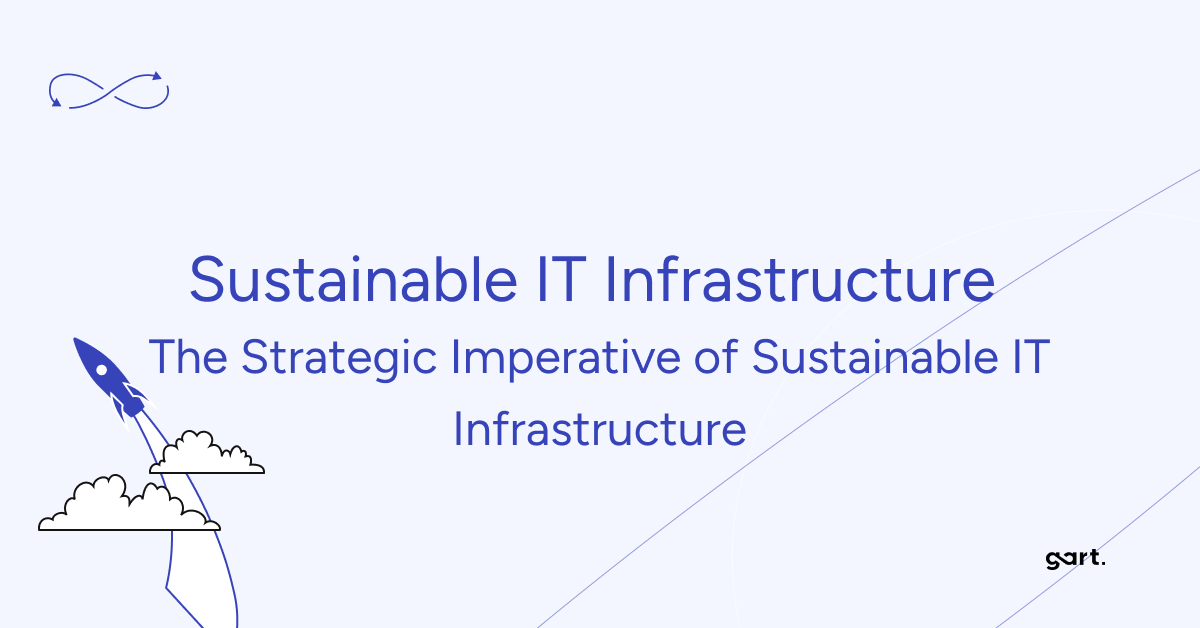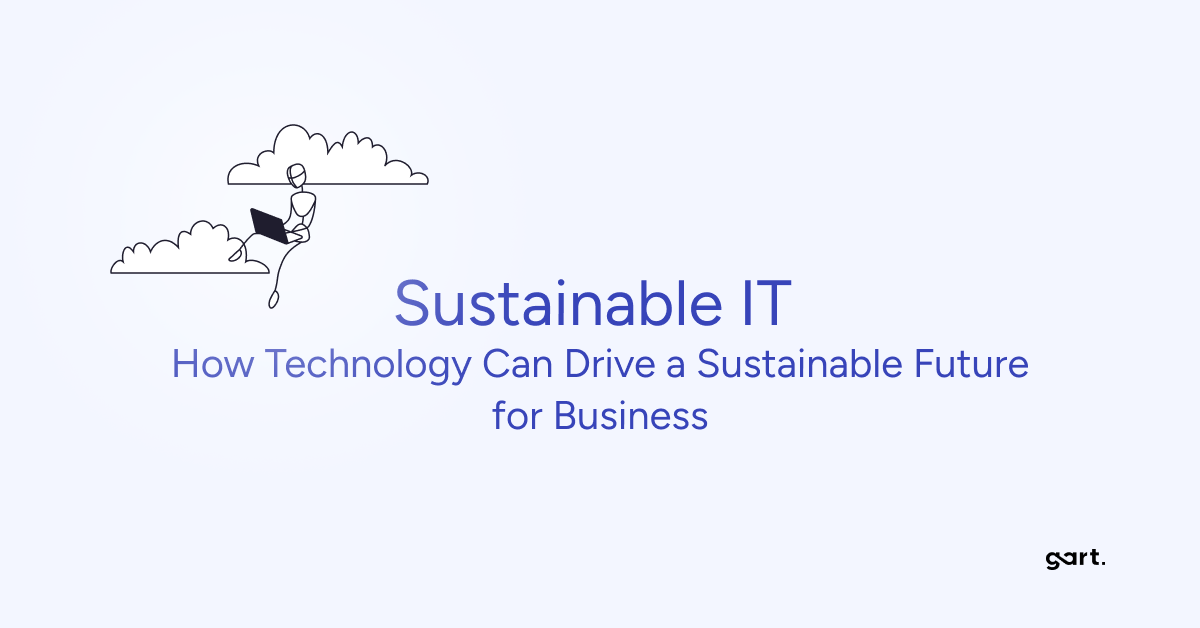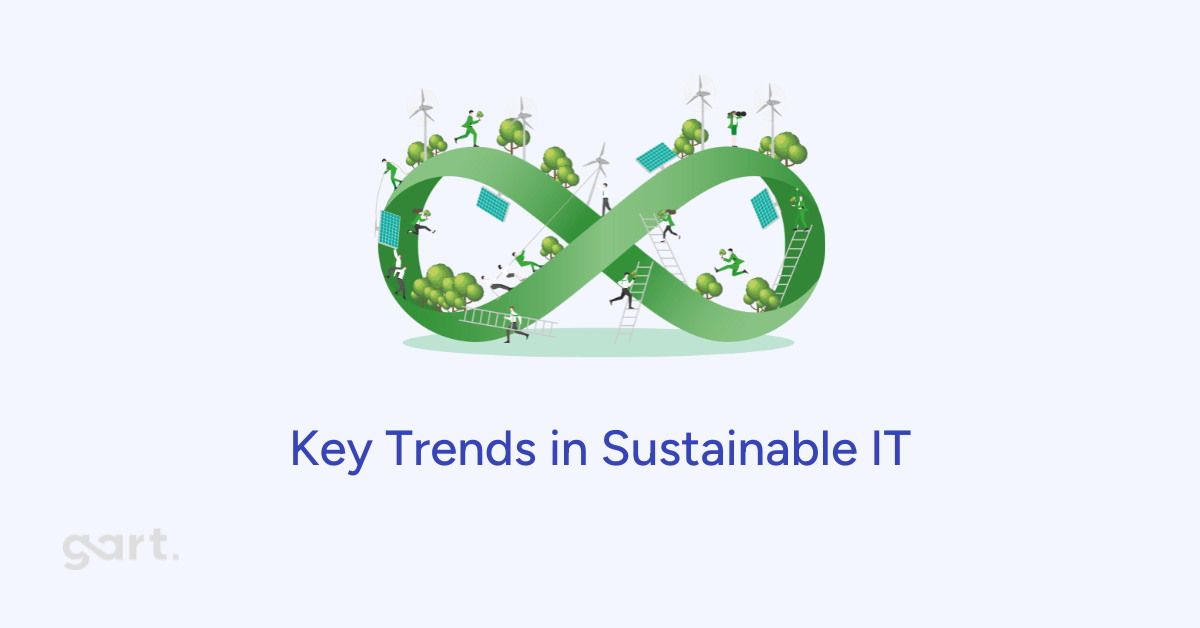What’s green computing all about?
Sustainable IT isn’t just a buzzword anymore. It’s no longer just about turning off the lights or making sure servers aren’t eating up all the energy. It’s about completely rethinking how we handle IT and making it work smarter—not just for the business, but for the planet, too. We’re talking about a holistic approach that covers everything from the servers and storage systems to the networks, and yes, even the energy that powers them—all through their entire lifecycle.
A truly sustainable IT infrastructure is built from the ground up with eco-friendly design, manufacturing, and disposal in mind. It’s not just about saving the planet; it’s about creating a business model that works for people and profits, too. It’s a strategy that’s as much about social fairness and long-term economic growth as it is about environmental stewardship. In short? Sustainability is the heartbeat of any modern, forward-thinking company. It’s no longer a “nice-to-have”; it’s woven right into your business’s DNA.
The Triple Bottom Line: People, Planet, and Profit
One of the best ways to wrap your head around all of this is by looking at the “Triple Bottom Line” approach. This is where success is measured across three interconnected pillars: People, Planet, and Profit.
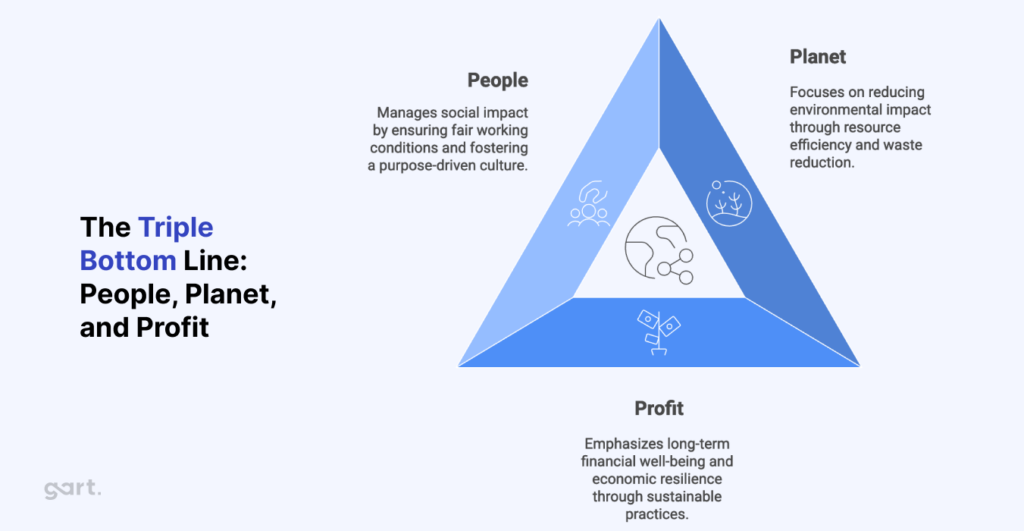
Planet (The Green Stuff):
This one’s the most straightforward—it’s about reducing your environmental footprint. This includes cutting back on energy consumption, minimizing waste, and, most importantly, slashing harmful emissions (we’re looking at you, carbon). But it’s not just about reducing the damage. It’s about making IT work in harmony with the planet’s natural cycles, helping us fight climate change and preserve our resources for future generations.
Profit (The Dollars & Cents):
Think going green means going broke? Think again. Sustainability isn’t just a moral choice—it’s a smart business move. By optimizing resources, streamlining processes, and cutting down on energy costs, you’re setting up your business for long-term financial health. Sustainable practices lead to real savings and long-term growth. The key is balancing the growth of your business with smart, efficient use of resources, and that’s where real profits are made.
People (The Human Element):
It’s not all about numbers. People matter too. For IT infrastructure to be truly sustainable, it has to consider the impact on employees, customers, and the wider society. Think fair wages, healthy work conditions, and a purpose-driven culture that attracts top talent. When businesses focus on social sustainability, they don’t just gain a motivated workforce—they build a loyal customer base and earn the trust of their communities.
Need help turning energy savings into measurable ROI? Gart’s cloud cost-optimization and platform engineering services help teams consolidate infrastructure and cut recurring costs — without compromising performance. See cost-saving case studies
The following table provides a clear overview of how these three pillars are interconnected within a sustainable IT strategy.
Table 1: The Triple Bottom Line of Sustainable IT
| Pillar | Definition & Core Focus | Strategic IT Benefits |
| Planet (Environmental) | Minimizing impact on the natural environment, reducing resource consumption, and managing emissions and waste. | Lower energy consumption and emissions, reduced e-waste, and increased resilience to climate-related disruptions. |
| Profit (Economic) | Fostering long-term financial well-being and balancing economic growth with resource efficiency. | Significant operational cost savings, increased market share, improved long-term viability, and a stronger competitive advantage. |
| People (Social) | Managing a business’s impact on its employees, stakeholders, and communities. | Enhanced brand reputation, improved employee morale and retention, and increased market opportunities with sustainability-minded customers. |
Sustainability Isn’t Just a Choice, It’s a Business Necessity
There’s a perfect storm of reasons why sustainability has gone from “nice-to-have” to “we can’t ignore this anymore.” External pressures from consumers and regulators, combined with internal pushes from employees and execs, are all calling for a greener, more sustainable IT ecosystem.
The Planet’s Wake-Up Call: The Environmental Impact of Our Digital World
Let’s face it—the digital world is growing at lightning speed, and so is the environmental price tag. Data centers, those vast facilities that power everything from our favorite apps to cloud storage, are becoming an environmental concern we can no longer ignore. In 2022, data centers consumed a whopping 460 terawatt-hours (TWh) of energy, about 2% of the world’s total electricity use. And that number? It’s set to double by 2026. Why? Because the demand for data—and the services that store it—is growing, fast.
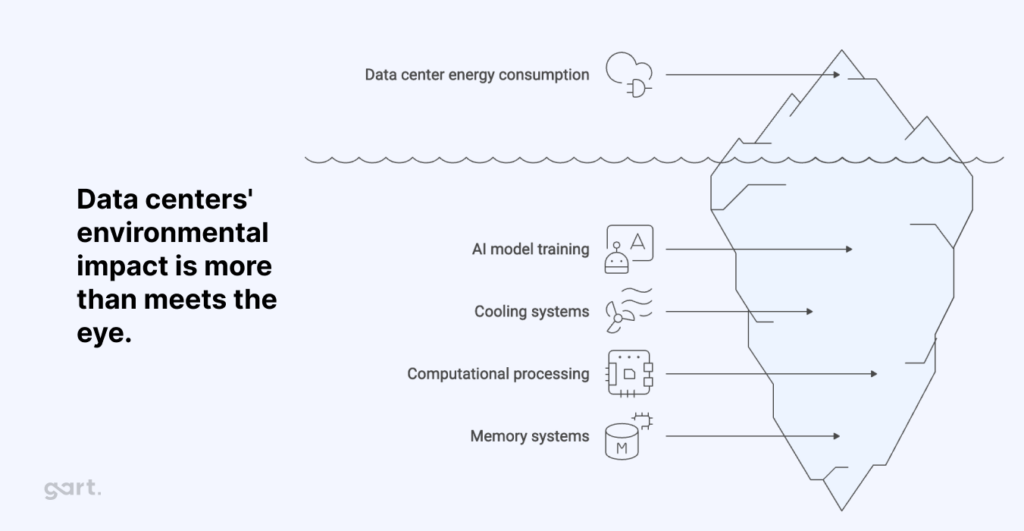
A big part of this growth is thanks to artificial intelligence (AI). AI is superpowering this expansion, but training AI models requires a mountain of energy. These data centers use as much electricity as a small city, and it’s not just for processing data. Memory systems and cooling tech are all sucking down power to manage the heat generated by those AI workloads. The rapid rise of AI is pushing our infrastructure to its limits, proving the urgent need for more sustainable, energy-efficient solutions.
Migrate to greener infrastructure. Gart designs cloud and hybrid architectures that reduce PUE and Scope 2 emissions. Start a sustainability migration audit.
The Economic Case: Saving Money and Winning in the Market
Sustainable IT isn’t just good for the environment—it’s a goldmine for your bottom line. Sure, the obvious benefit is slashing operational costs. Even a small tweak, like consolidating a single server, can save around $2,500 a year, with $500 of that coming straight from energy savings. Scale that across your entire business, and you’re looking at significant cost relief.
But the real game-changer? It’s the long-term strategic value. Companies with solid Environmental, Social, and Governance (ESG) practices consistently outperform the market. That’s right—investing in sustainability today translates to bigger financial rewards tomorrow. Plus, it helps safeguard your brand and avoids costly risks. If your company’s caught in a PR disaster or faces a fine for ignoring environmental regulations, that’s not just a hit to your reputation—it’s a distraction from your real business.
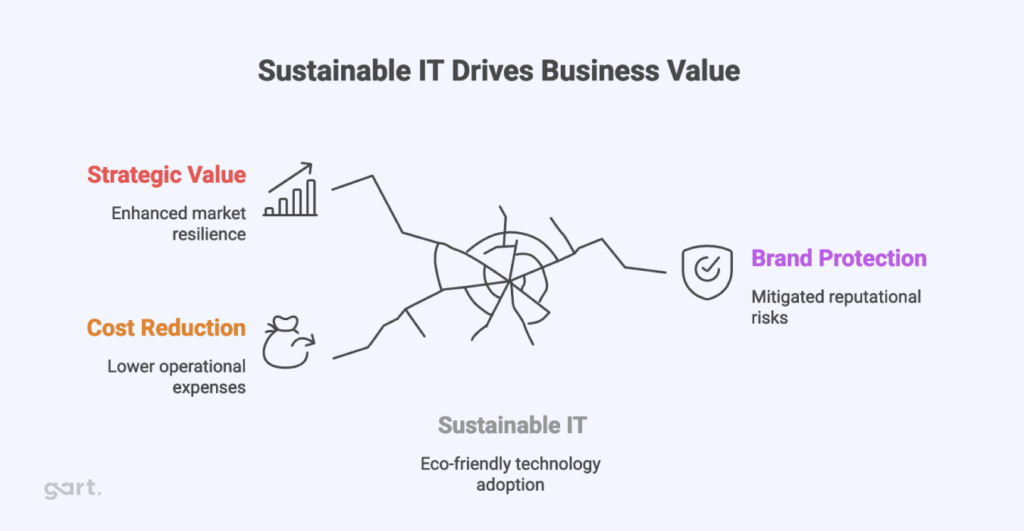
The People Factor: Building Your Brand and Attracting Top Talent
Today, being a purpose-driven company isn’t just a nice thing to do—it’s a competitive edge. Employees want to work for organizations that care about the planet. Research shows that employees feel more connected to companies with strong environmental commitments. And that connection? It leads to happier, more engaged employees, and even better retention rates.
Plus, a company that prioritizes social and environmental sustainability looks good to customers, too. A 2019 study found that 73% of global consumers are ready to change their buying habits to reduce their negative environmental impact. That’s a huge opportunity for businesses that want to capture the growing demand for sustainable products and services.
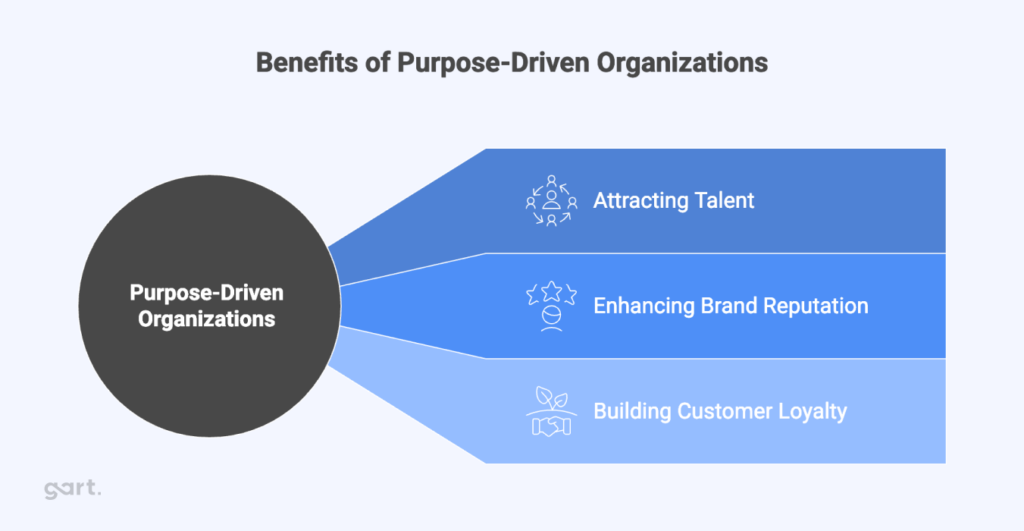
The Regulatory Pressure: Navigating the Maze of ESG Frameworks
It’s not just consumers and employees pushing for sustainability. Governments and regulators are ramping up the pressure. ESG metrics are quickly becoming the industry standard for measuring how ethical and sustainable your business really is. Whether it’s cost forecasts, vendor negotiations, or board-level risk assessments, you can bet that sustainability will play a big role.
Companies now need to meet expectations by aligning their reporting with key frameworks like the Task Force on Climate-related Financial Disclosures (TCFD) and the Global Reporting Initiative (GRI). And here’s where it gets even more interesting: “double materiality.” It’s not just about how climate change affects your business; it’s also about how your operations affect the planet. That means your supply chain matters, too. Sustainability doesn’t stop at your doorstep—it extends through your entire vendor network. That’s why selecting the right partners is just as important as reducing your own emissions.
Ready to make IT sustainable and cost-efficient? Gart Solutions helps teams audit, migrate and operate greener infrastructure — from strategy to production. Request a sustainability audit
The Pillars of Practice: Implementing Sustainable IT
Sustainable IT isn’t just about setting lofty goals—it’s about taking concrete steps at every level of your tech stack. From the servers that power your operations to the software running on them, there are specific practices and technologies that make up the backbone of a green IT strategy. Here’s how to get it right.
Data Centers: The Heart of the IT Beast
Energy efficiency should be at the top of the list when it comes to data centers. These massive facilities are huge energy guzzlers, so every watt counts. One key metric to track is Power Usage Effectiveness (PUE). If your PUE is 2.0, that means for every watt used by your IT equipment, another watt goes toward cooling and lighting. Ideally, you want that number closer to 1.0. But don’t stop there—metrics like Carbon Usage Effectiveness (CUE) and Water Usage Effectiveness (WUE) are gaining ground too. They give you the full picture by factoring in the carbon footprint of energy used and how much water’s being consumed.
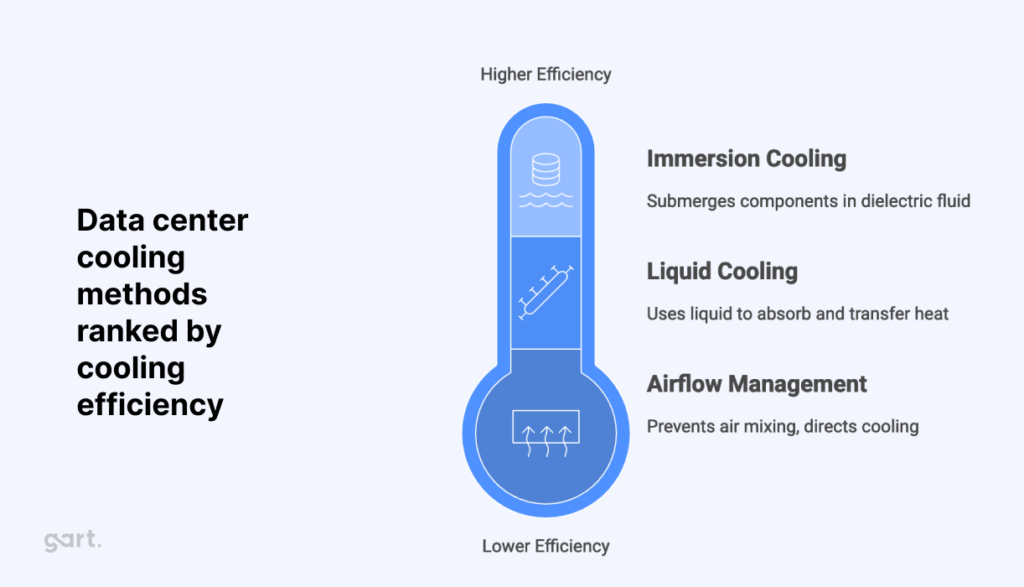
Advanced Cooling Tech: Keeping It Cool (Without Wasting Energy)
Traditional cooling systems can eat up as much as 40% of a data center’s energy bill. And as AI and high-performance computing (HPC) ramp up, the need for better cooling solutions has never been greater. So, what’s the fix?
- Liquid Cooling: Instead of blowing air over servers, liquid cooling pumps water through pipes to remove heat. Water can absorb a lot more heat than air, and that means less energy needed. Plus, you can reuse the waste heat—turning it into a resource for nearby buildings or even greenhouses. Pretty cool, right?
- Immersion Cooling: For high-density workloads (think AI), immersion cooling is a game-changer. This involves submerging IT components in a non-conductive liquid that absorbs the heat directly. The result? A smaller footprint with better space utilization, meaning less infrastructure and fewer resources required.
- Airflow Management: For more traditional setups, airflow management can make a huge difference. With hot and cold aisle containment, you create separate corridors for cool and hot air, making sure the chilled air goes exactly where it’s needed. Less energy, more efficiency.
See how Gart built a compliant, scalable cloud infrastructure for an AI medical app — secure, efficient, ready for heavy workloads. Read the MedWrite.AI case study
Modular and Scalable Design: Growing Smart, Not Fast
Modular data centers are designed to scale only when it’s needed, avoiding the waste of overbuilding. This means that infrastructure growth aligns with business demand, keeping things lean and efficient, both in terms of resources and costs. It’s like having the flexibility to expand as your business grows, without wasting a ton of energy or money upfront.
Hardware and Lifecycle Management
Sustainability isn’t just about what’s in the server room—it’s about everything that goes into your tech, from the very first design all the way to the day it’s retired. Here’s how to handle it:
Sustainable Sourcing
IT leaders should think of waste management as part of the infrastructure, not just something that happens at the end. That means asking vendors for carbon disclosure reports and understanding their energy mix. It’s also about considering how raw materials are sourced and the impact manufacturing processes have on the environment.
E-Waste Management
The world produces a staggering 54 million metric tonnes of e-waste every year, and only 20% of it gets recycled. If e-waste is improperly disposed of, it can release harmful toxins into the environment. A solid sustainable strategy includes designing products for longevity and repairability, along with having effective e-waste management in place to ensure old tech gets recycled properly. This is the kind of circular economy approach that helps reduce waste and keep resources in use longer.
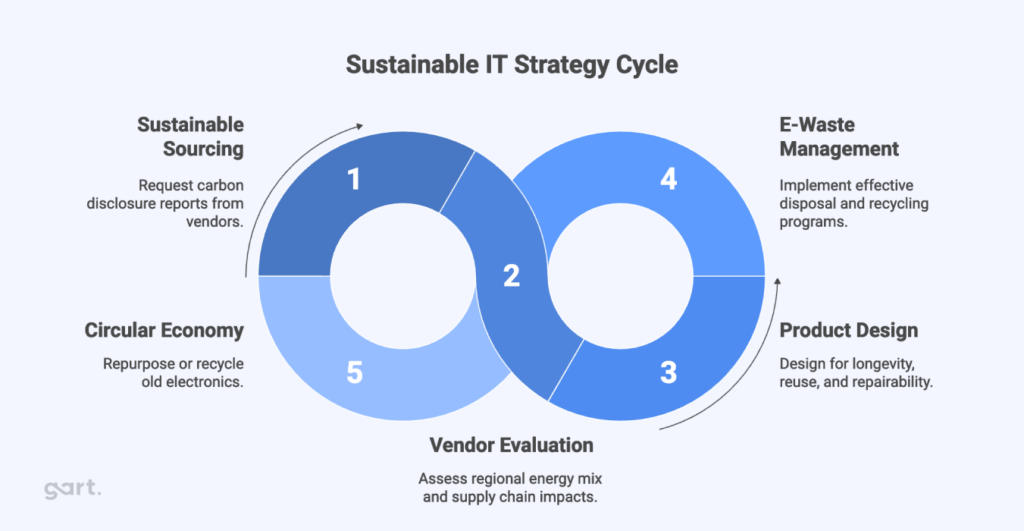
Leveraging the Cloud: Going Green Without Losing Power
Shifting workloads to the cloud is one of the best ways to boost sustainability. Big cloud providers like Google, Microsoft, and AWS have the resources to power their massive data centers with renewable energy and use advanced cooling technologies that smaller on-premises setups can’t match. Plus, the cloud’s scalability means you don’t need to manufacture and install servers every time you need more capacity. It’s a cleaner, greener way to grow your IT infrastructure without the extra emissions from physical hardware production.
Table 2: A Comparative Analysis: The Sustainability of Cloud vs. On-Premises
| Feature | Cloud Computing | On-Premises Infrastructure |
| Energy Efficiency | Generally more efficient due to economies of scale and advanced cooling techniques. | Often less efficient due to a lack of scale and older cooling technologies, with cooling accounting for a significant portion of energy use. |
| Physical Infrastructure | Reduces the need for on-site physical hardware, saving energy and minimizing e-waste. | Requires a physical server estate that must be purchased, powered, and maintained, leading to higher energy consumption and a larger physical footprint. |
| Scalability | Dynamically scales on demand, reducing the need to produce and install new servers for business growth. | Scaling requires the physical procurement, installation, and powering of new servers and equipment. |
| Access to Renewables | Hyperscalers often have massive purchasing agreements for renewable energy, powering their facilities with clean sources like solar and wind. | Access to renewable energy is limited to a company’s location and utility provider, often relying on mixed grids. |
| E-Waste | Contributes to a reduction in e-waste at the organizational level by minimizing the need to purchase and dispose of hardware. | Creates e-waste when hardware reaches the end of its useful life, requiring effective management and disposal programs. |
It is important to note the shared responsibility model in the cloud. While providers are responsible for the sustainability of the cloud through their efficient infrastructure, customers are responsible for sustainability in the cloud by optimizing their workloads and resource utilization.
Sponsored insight: teams moving complex workloads to cloud often see immediate energy and hardware savings — Gart helps map, migrate and optimize with minimal disruption. Get a migration roadmap
Green Software Engineering
Even the best hardware and most efficient data centers can be undermined by inefficient software. If your code isn’t optimized, you’re essentially throwing away all the energy savings you worked so hard to build. Sustainable software development is about writing smarter code that reduces the amount of processing power and memory needed. Here’s how you can make your software greener:
- Energy and Carbon Efficiency: Build applications that run on as little power as possible. This includes using energy-efficient programming languages and platforms, plus optimizing your code to enter low-power states when it’s idle.
- Network Efficiency: Cut down on the amount of data being sent across the network, and minimize the distance it has to travel. Less is more when it comes to data.
- Demand Shaping: Create applications that are “carbon-aware”—meaning they adjust their resource usage based on demand. Don’t leave machines running when they’re not needed.
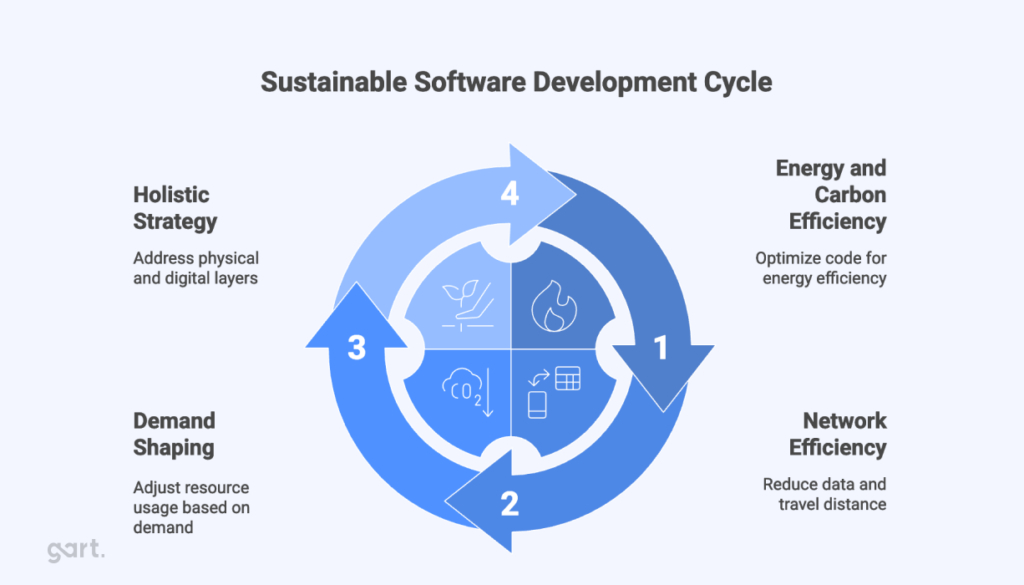
The Sustainable Software Development Life Cycle (S-SDLC) isn’t about reinventing the wheel. It’s about adding sustainability into every stage of the development process. For example, a “Green AutoScaler” developed for the financial sector monitors cluster load and adjusts its size accordingly. By scaling down during low-demand times, it cut costs by 70% and drastically reduced carbon emissions. Proof that a holistic approach—one that covers both physical infrastructure and digital processes—works wonders.
Optimize code & CI/CD to cut runtime energy. Gart’s DevOps and CI/CD teams implement autoscaling and efficiency measures that reduce cloud consumption. Talk to a DevOps architect
New Frontiers: AI and Machine Learning in Green IT
Funny enough, the same tech that’s driving up energy consumption is also the answer to reducing it. Artificial Intelligence (AI) and Machine Learning (ML) are the secret weapons for optimizing processes, predicting failures, and automating tasks to reduce energy waste.
Take Google’s DeepMind AI, for example. It slashed the energy used for cooling in its data centers by 40%, which led to a 15% decrease in overall energy usage (PUE). How? The system pulls real-time data from thousands of sensors, feeds it into deep neural networks, and predicts which cooling actions will use the least energy—while still keeping everything safe. This kind of intelligent, real-time optimization is a giant leap beyond static control systems, making it one of the most exciting advancements in energy management.
Measuring Success: Metrics, Reporting, and the Business Case
To measure how well you’re doing with sustainability, IT leaders need some clear and straightforward key performance indicators (KPIs). Here’s what you need to know to keep track of your progress:
Key Metrics for Data Center Efficiency
To measure progress effectively, IT leaders need a clear understanding of the key performance indicators (KPIs) for sustainability.
Table 3: Key Data Center Efficiency Metrics
| Metric | What it Measures | Why it Matters |
| Power Usage Effectiveness (PUE) | The ratio of total facility power to the power consumed by IT equipment. | It remains the go-to benchmark for data center efficiency. A lower PUE (closer to 1.0) indicates a more efficient data center. |
| Carbon Usage Effectiveness (CUE) | The total carbon footprint of the data center compared to the carbon emissions from IT equipment. | It provides a more complete picture of environmental impact than PUE alone, which is essential for sourcing from mixed power grids and for ESG reporting. |
| Water Usage Effectiveness (WUE) | The ratio of a data center’s annual water consumption to its IT equipment energy use. | This is a critical variable as water conservation becomes a shared concern. Data centers can consume millions of gallons of water per day, and this metric helps track water efficiency. |
Understanding Your Footprint: Scope 1, 2, and 3 Emissions
When it comes to tracking carbon emissions, the Greenhouse Gas (GHG) Protocol breaks it down into three categories. It’s not just about the immediate stuff—it’s about the bigger picture.
- Scope 1: These are the emissions that come directly from what you own or control, like on-site generators, boilers, or even leaks from your cooling systems. Think of it as your company’s “direct emissions.”
- Scope 2: These are indirect emissions from the energy you buy—things like electricity, heating, or cooling. If you’re running a data center, this is where your direct electricity use falls in.
- Scope 3: These are the trickier ones—indirect emissions that come from your entire supply chain. For most companies, Scope 3 accounts for a massive chunk of emissions—sometimes 90%! This includes things like the manufacturing and disposal of hardware, business travel, and even employee commuting.
What does this tell us? Sustainability isn’t just about optimizing your own operations (Scopes 1 and 2)—it’s about making sustainable choices across your entire value chain. Vendor selection and how you handle end-of-life products aren’t just tech decisions; they’re strategic ones. Choosing the right suppliers can make a huge difference in your overall sustainability impact, and that means your entire supply chain becomes part of the solution.
Calculating the ROI of Sustainability
Okay, now you’re probably wondering—what’s the ROI of all this sustainability work? How do you measure if it’s worth the effort?
The simple formula is:
ROI (%) = (Gains – Cost) / Cost x 100
But when it comes to sustainability projects, it’s not always as simple as just adding up the numbers. There’s more to it than a traditional IT project.
Here’s the breakdown:
- Costs: Yep, there’s an initial investment—new technology, labor, R&D, all that good stuff. It’s not cheap up front.
- Tangible Gains: These are the easy-to-measure benefits. Think operational savings from cutting energy or water consumption. For example, consolidating a server could save you around $2,500 a year.
- Intangible Gains: These are a bit trickier to measure, but trust me—they’re often the most valuable. Revenue can go up as the market for sustainable products grows, and you’re saving money by avoiding risks like fines or damage to your reputation. Plus, happier employees are more productive, and keeping your staff around longer saves you money on turnover.
To get the full picture, you can use the Social Return on Investment (SROI) framework. This looks beyond just the dollar signs and gives a value to social, environmental, and economic impacts—offering a fuller view of the value you’re generating per investment.
Table 4: Calculating ROI for Sustainable IT Projects
| Category | Example Costs and Gains | How to Quantify |
| Project Costs (Tangible) | Hardware upgrades, new cooling systems, renewable energy installations, labor, and R&D. | Sum all direct financial outflows for the project. |
| Project Gains (Tangible) | Reduced energy bills, water savings, decreased waste disposal costs. | Use utility bills and other operational data to calculate the difference from the baseline. |
| Project Gains (Intangible) | Enhanced brand reputation, increased customer loyalty, improved employee retention, and risk mitigation. | Translate these benefits into monetary terms, for example, by calculating the value of avoided fines or the increased revenue from a stronger brand. |
| Formula & Example | ROI (%) = (Gains − Cost) ÷ Cost × 100.28 An investment costing $80,000 that saves $50,000 per year over five years has an ROI of 212.5%. | Separate tangible and intangible benefits for an objective and accurate projection. |
Navigating the Hurdles: Challenges and Strategic Solutions
While the case for sustainable IT is clear, the road to making it happen isn’t without its bumps. But don’t worry—these challenges aren’t impossible to overcome. With the right approach and a little patience, they can be turned into opportunities.
The Challenge of Upfront Costs
One of the biggest hurdles to adopting sustainable technology is the upfront cost. Renewable energy systems and advanced cooling setups can be pricey, especially for small businesses or organizations with tight budgets. But here’s the kicker: these costs aren’t just a burden—they’re an investment. As the ROI analysis shows, the savings on operational costs add up over time. A “smart growth” approach, where businesses are designed for long-term sustainability, can slash future infrastructure costs significantly.
Leading companies are already proving this. Microsoft, for example, isn’t just spending billions on renewable energy-powered AI—it’s pre-paying for the energy and infrastructure it will use in the future. That’s not just a cost; it’s a strategic investment that secures their computing power and keeps their energy prices stable. The result? A competitive advantage that others will have to catch up to.
Technological and Infrastructure Barriers
Another hurdle is outdated tech. Many data centers were built years ago and may need major upgrades or a full overhaul to meet green standards. Plus, there’s a skill gap—managing sustainable infrastructure requires expertise in green architecture and energy modeling, which is still in short supply.
But here’s the good news: the industry is working on it. Older facilities can be retrofitted with modern improvements like liquid cooling, better airflow management, and server virtualization. These updates significantly reduce the carbon footprint without needing to rebuild from scratch. To fill the skills gap, companies like Microsoft are partnering with educational institutions to train the next generation of data center professionals.
The Power Supply Puzzle
Grid reliability is another challenge. With the explosion of demand, especially from AI, the local power grid is starting to feel the pressure. But here’s how the big players are responding: by becoming champions of the green energy transition themselves. Hyperscalers are making huge investments in renewable energy and working with local utilities to create a reliable and sustainable power supply. This is no longer just about using green energy; it’s about shaping the future of the grid to support growing digital demands.
Gart Solutions — build efficient, compliant cloud infrastructure that lowers energy and operating costs. Book a free cloud checkup.
Real-World Case Studies: Inspiration in Action
The best way to understand the power of sustainable IT is through the stories of companies that are already leading the way. These case studies prove that sustainability isn’t just a nice-to-have; it’s a game-changing, multi-faceted approach that’s reshaping business models.
Hyperscalers Lead the Charge
- Google: The company operates carbon-neutral data centers and is aiming for 24/7 carbon-free energy by 2030. A big part of this is using DeepMind AI to reduce energy consumption for cooling by 40%, saving costs and slashing environmental impact at the same time.
- Microsoft: Microsoft has hit 100% renewable energy usage across its global data centers and is investing billions in renewable-powered AI infrastructure. A $6 billion deal for a new AI facility in Northern Norway shows just how committed they are to scaling AI with clean energy.
- Amazon Web Services (AWS): AWS has been actively working to reduce emissions from its data centers, using renewable energy and cutting-edge cooling systems. They’ve helped clients like Toyota reduce their carbon footprint by 95%, proving that cloud technology can help others hit their sustainability targets too.
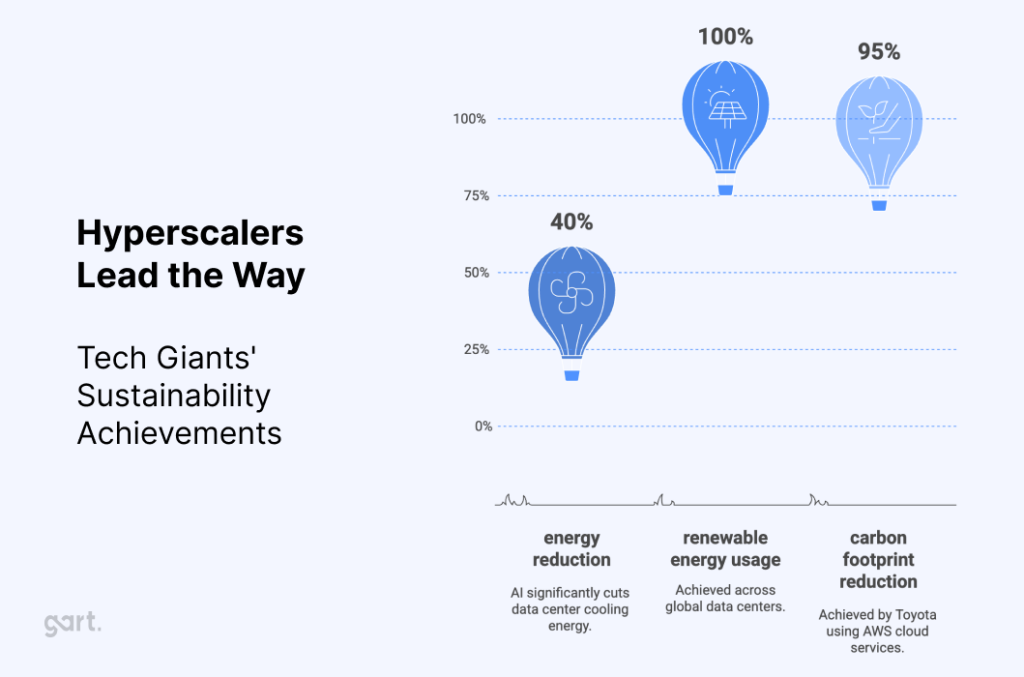
Innovation Beyond the Cloud
Sustainability isn’t just a tech industry trend—it’s spreading across all sectors.
- HP: HP created video collaboration tools to cut down on business travel, tackling Scope 3 emissions tied to employee mobility.
- Apple: Apple’s LEED-certified data center in North Carolina gets 90% of its power from renewable sources, like solar panels and fuel cells. They’ve almost made their data center entirely self-sufficient.
- General Electric (GE): GE is using IoT and digital twins to optimize wind turbine performance, boosting green energy efficiency in wind farms.
- H&M: H&M’s “Let’s Close the Gap” program encourages customers to recycle old clothes, pushing for a circular economy model that also extends to tech and e-waste.
The Future of Sustainable IT Infrastructure
The future of sustainable IT is full of exciting possibilities. Emerging technologies and trends will continue to reshape the way we build, manage, and use technology, creating greener and more efficient systems.
Emerging Trends and Technologies
- Edge Data Centers: By bringing data processing closer to users, edge data centers reduce latency, power consumption, and can tap into more localized, cleaner energy sources.
- AI-Optimized Energy Management: AI is going beyond just cooling to optimize energy use across the entire data center, from hardware to workload distribution.
- Circular IT Strategies: The focus will shift to designing products for longevity, repairability, and reuse. This will help minimize the need for new hardware and reduce e-waste.
The Path Forward for Organizations
So, how can organizations take the first step toward sustainable IT? The key is a strategic approach. Start by measuring where your energy is going, so you can track your emissions and consumption in real-time. Without that visibility, it’s hard to make meaningful progress.
Next, create a clear roadmap with SMART (Specific, Measurable, Actionable, Realistic, Time-bound) sustainability goals. And don’t treat sustainability as just another checkbox—it should be baked into every part of your business. It’s not just about reporting; it’s about transforming your business for a more sustainable, resilient future.
Conclusion: a Call to Strategic Action
Sustainable IT infrastructure is no longer optional—it’s a strategic necessity. It drives long-term value, encourages innovation, and helps companies stay resilient in the face of global challenges. The road to sustainability has its obstacles, but with the right mindset and tools, they’re manageable.
The evidence is clear: the companies that will thrive are the ones that integrate sustainability into their corporate DNA. By starting with visibility, leveraging the right technologies, and building a solid business case, businesses can cut their environmental footprint while unlocking new opportunities for profitability and growth.
See how we can help to overcome your challenges

